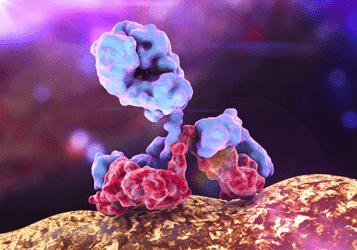- Home
- Products
- Customized ADCs
- ITGAE
- Anti-ITGAE-MCC-DM1 ADC-1
Anti-ITGAE-MCC-DM1 ADC-1 (CAT#: ADC-W-534)
This ADC product is comprised of an anti-ITGAE monoclonal antibody (clone M290) conjugated via a MCC linker to DM1. The DM1 is targeted to certain cancers by immunerecognition and delivered into cancer cells via receptor mediated endocytosis. Within the cell, DM1 binds to tubulins, interrupts microtubule dynamics, and subsequently, induces cell death.
- Product Information
- ADC Target
- ADC Antibody
- ADC Linker
- ADC payload drug
- Antibody clone #
- M290
- Name
- ITGAE
- Alternative Names
- ITGAE; integrin, alpha E (antigen CD103, human mucosal lymphocyte antigen 1; alpha polypeptide); CD103; HUMINAE; integrin alpha-E; HML-1 antigen; integrin alpha-IEL; mucosal lymphocyte 1 antigen; antigen CD103, human mucosal lymphocyte antigen 1; alpha po
- Target Entrez Gene ID
- 3682
- Target UniProt ID
- P38570
- Overview
- Integrins are heterodimeric integral membrane proteins composed of an alpha chain and a beta chain. This gene encodes an I-domain-containing alpha integrin that undergoes post-translational cleavage in the extracellular domain, yielding disulfide-linked heavy and light chains. In combination with the beta 7 integrin, this protein forms the E-cadherin binding integrin known as the human mucosal lymphocyte-1 antigen. This protein is preferentially expressed in human intestinal intraepithelial lymphocytes (IEL), and in addition to a role in adhesion, it may serve as an accessory molecule for IEL activation.
- Overview
- Anti-ITGAE Antibody, clone # M290
- Clone #
- M290
- Species Reactivity
- Mouse
- Name
- Mcc (Maleimidomethyl cyclohexane-1-carboxylate)
- Description
- Noncleavable linkers, is considered noncleavable-meaning linker cleavage, and payload release does not depend on the differential properties between the plasma and some cytoplasmic compartments. Instead, the release of the cytotoxic drug is postulated to occur after internalization of the ADC via antigen-mediated endocytosis and delivery to lysosomal compartment, where the antibody is degraded to the level of amino acids through intracellular proteolytic degradation.
- Name
- DM1 (N2’-Deacetyl-N2’-(3-mercapto-1-oxopropyl)maytansine)
- Description
- Derived from Maytansinoid,a group of cytotoxins structurally similar to rifamycin, geldanamycin, and ansatrienin. The eponymous natural cytotoxic agent maytansine is a 19-member lactam (ansa
macrolide) structure originally isolated from the Ethiopian shrub Maytenus ovatus. Maytansinoids can bind to tubulin at or near the vinblastine-binding site, which interfere the formation of microtubules and depolymerize already formed microtubules, inducing mitotic arrest in the intoxicated cells.
For Research Use Only. NOT FOR CLINICAL USE.
Related Products
- Anti-24P4C12-VC-MMAE ADC (CAT#: ADC-W-017)
- Anti-TGFB1 (Fresolimumab)-SMCC-DM1 ADC (CAT#: ADC-W-1796)
- Anti-MS4A1 (Technetium (99mTc) nofetumomab merpentan)-SMCC-DM1 ADC (CAT#: ADC-W-1586)
- Anti-RhD (Morolimumab)-MC-Vc-PAB-DMEA-(PEG2)-duocarmycin SA ADC (CAT#: ADC-W-1729)
- Anti-FGFR2-sulfo-SMCC-DM1 ADC-13 (CAT#: ADC-W-063)
- Anti-IAV HA (Diridavumab(CR6261))-SPDB-DM4 ADC (CAT#: ADC-W-2067)
- Anti-ERBB2 (Trastuzumab)-MMAD ADC (CAT#: ADC-W-408)
- Anti-TNFRSF8 (Brentuximab)-DBCO-MMAF ADC-6 (CAT#: ADC-W-253)
- Anti-TNFRSF8-VC-MMAF ADC-12 (CAT#: ADC-W-345)
- Anti-BSG (Ziralimumab)-MC-Vc-PAB-DMEA-(PEG2)-duocarmycin SA ADC (CAT#: ADC-W-727)
Published Data
+ Submit Publications

Scientific Resources
Customer Reviews and FAQs
There are currently no Customer reviews or questions for ADC-W-534. Click the button above to contact us or submit your feedback about this product.
Quick Links
Other Products
Same Target
Same Linker
Same Payload
| CAT# | Product Name | Linker | Payload |
| ADC-W-533 | Anti-ITGAE-Mc-MMAF ADC-1 | Mc (maleimidocaproyl) | MMAF (Monomethyl auristatin F) |
| ADC-W-532 | Anti-ITGAE-Mc-VC-PABC-MMAE ADC-1 | MC-VC-PABC (maleimidocaproyl-valine-citrulline-p-aminobenzoyloxycarbonyl) | MMAE (Monomethyl auristatin E) |
| CAT# | Product Name | Linker | Payload |
| ADC-W-511 | Anti-ERBB2-MCC-DM1 ADC-2 | MCC (Maleimidomethyl cyclohexane-1-carboxylate) | DM1 (N2’-Deacetyl-N2’-(3-mercapto-1-oxopropyl)maytansine) |
| ADC-W-618 | Anti-MS4A1-MCC-DM1 ADC | MCC (Maleimidomethyl cyclohexane-1-carboxylate) | DM1 (N2’-Deacetyl-N2’-(3-mercapto-1-oxopropyl)maytansine) |
| ADC-W-610 | Anti-CD72-MCC-DM1 ADC | MCC (Maleimidomethyl cyclohexane-1-carboxylate) | DM1 (N2’-Deacetyl-N2’-(3-mercapto-1-oxopropyl)maytansine) |
| ADC-W-622 | Anti-CR2 (THB-5)-MCC-DM1 ADC | MCC (Maleimidomethyl cyclohexane-1-carboxylate) | DM1 (N2’-Deacetyl-N2’-(3-mercapto-1-oxopropyl)maytansine) |
| ADC-AA-054 | Protein A-MCC-DM1 ADC | MCC (Maleimidomethyl cyclohexane-1-carboxylate) | DM1 (N2’-Deacetyl-N2’-(3-mercapto-1-oxopropyl)maytansine) |
| CAT# | Product Name | Linker | Payload |
| ADC-W-496 | Anti-EGFR-SMCC-DM1 ADC | SMCC (N-succinimidyl 4-(Nmaleimidomethyl)cyclohexane-1-carboxylate) | DM1 (N2’-Deacetyl-N2’-(3-mercapto-1-oxopropyl)maytansine) |
| ADC-AA-018 | anti-HIgG(Fab)-N-DM1 ADC | Noncleavable linkers | DM1 (N2’-Deacetyl-N2’-(3-mercapto-1-oxopropyl)maytansine) |
| ADC-W-541 | Anti-CD44-DM1 ADC | DM1 (N2’-Deacetyl-N2’-(3-mercapto-1-oxopropyl)maytansine) | |
| ADC-AA-050 | Protein G-MCC-DM1 ADC | MCC (Maleimidomethyl cyclohexane-1-carboxylate) | DM1 (N2’-Deacetyl-N2’-(3-mercapto-1-oxopropyl)maytansine) |
| ADC-AA-031 | anti-MIgG(Fc)Fab-N-DM1 ADC | Noncleavable linkers | DM1 (N2’-Deacetyl-N2’-(3-mercapto-1-oxopropyl)maytansine) |
Online Inquiry
Welcome! For price inquiries, please feel free to contact us through the form on the left side. We will get back to you as soon as possible.



